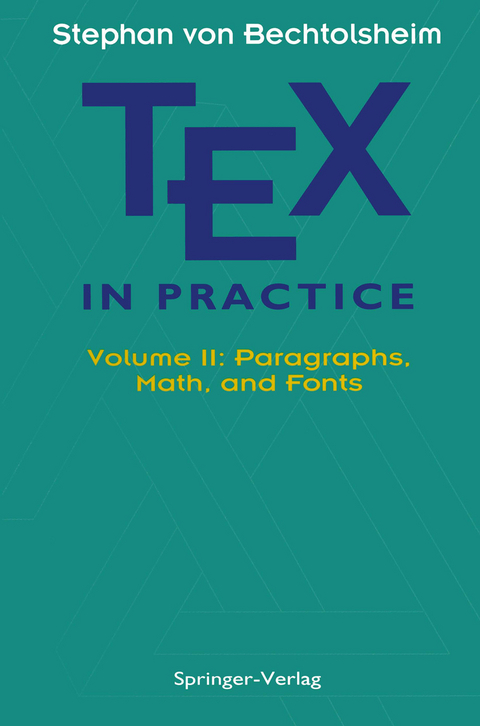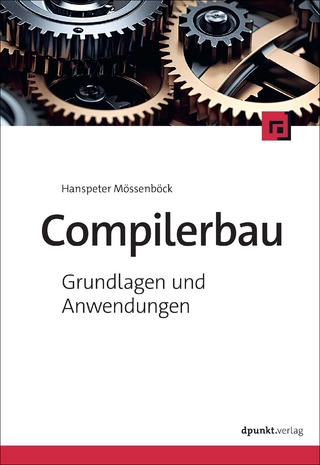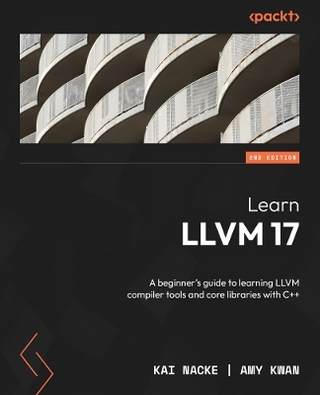
TEX in Practice
Springer-Verlag New York Inc.
978-1-4613-9141-8 (ISBN)
You might well wonder why TFPC in Practice is a part of the Monographs in Visualization series. However, if you really think about typesetting, especially fine typesetting, you soon realize that in large part it is a visual art as well as a science. 'lEX's algorithms produce in almost all cases aesthetic results of the highest quality. On the other hand, occasionally one may want to insert some additional space before a subscript or superscript, or one may want to adjust the vertical spacing in a fraction. Fortunately Donald Knuth, the author of 'lEX, allows one to program such corrections easily where needed. The four volumes of Stephan von Bechtolsheim's long awaited TFPC in Prac tice present a comprehensive view of 'lEX. His thorough discussion of each aspect of 'lEX is liberally laced with cogent illustrative examples. Many of these exam ples represent complete, ready to use macros that enhance the capabilities of 'lEX. These examples are of particular interest to both the typesetter and the 'lEX programmer. The typesetter can often solve an immediate problem by ei ther using one of the examples directly or by making minor changes to adapt it to the problem at hand. The 'lEX programmer can use the examples, along with Stephan's detailed discussion, to increase both the depth and breadth of his or her knowledge of 'lEX. The value of the text is further enhanced by Stephan's concerted effort to explain the reasoning behind each topic or example.
10 Building Paragraphs in TEX.- 10.1 The Basics.- 10.2 Parameters Defining Paragraph Shapes.- 10.3 Paragraphs and Vboxes.- 10.4 Starting a Paragraph.- 10.5 Ending a Paragraph.- 10.6 Indenting Paragraphs, /leftskip and /rightskip.- 10.7 Paragraph Indentation, /parindent.- 10.8 The Vertical Spacing Between Paragraphs, /parskip.- 10.9 The Token Parameter /everypar.- 10.10 User-Controlled Line Breaks.- 10.11 /parfillskip.- 10.12 Macro for Writing Paragraph Layout Parameters to the Logfile.- 10.13 Summary.- 11 Paragraphs, Part II.- 11.1 Generating Lists.- 11.2 Improved Macros for Lists.- 11.3 General List Macros.- 11.4 Hanging Indentations (/hangindent, /hangafter).- 11.5 A Generic Heading Printing Macro.- 11.6 Using /leftskip and /rightskip with Stretchability.- 11.7 Summary.- 12 Paragraphs, Part III.- 12.1 General Paragraph Shapes, /parshape.- 12.2 Timing Issues in Paragraph Parameters.- 12.3 Vertical Material Trickery, /vadjust.- 12.4 Table of Contents Typesetting.- 12.5 /prevgraf.- 12.6 Now It Is Playtime.- 12.7 The Line Breaking Algorithm and Hyphenation.- 12.8 Various Topics.- 12.9 Summary.- 13 Typesetting Math Equations with TEX.- 13.1 Basics of Typesetting Mathematical Equations.- 13.2 Special Math Symbols and Characters.- 13.3 Fractions and Fraction-Like Constructs.- 13.4 Math Accents.- 13.5 Large Operators.- 13.6 Delimiters.- 13.7 Horizontal Spacing in Math Modes.- 13.8 Inline Mathmode.- 13.9 Summary.- 14 More on Math.- 14.1 Converting Math Formulas Into Printed Output.- 14.2 A Closer Look at Atoms.- 14.3 Assigning Class, Family and Character Code to a Character.- 14.4 Style Selection in Math Modes.- 14.5 Fonts and Font Families in Math Mode.- 14.6 Braces.- 14.7 Vertical Spacing, Phantoms, Struts in Math Formulas.- 14.8 How to Input Mathematical Equations.- 14.9 Display Math Mode.- 14.10 Multiline Displays.- 14.11 Token Parameters /everymath and /everydisplay.- 14.12 Single and Double Math Shift Characters.- 14.13 Summary.- 15 Fonts in TEX.- 15.1 Magnification.- 15.2 The Basics of the Handling of Fonts by TEX.- 15.3 The Fonts of TEX.- 15.4 Font Sizes and Line Spacing.- 15.5 Fonts in the Plain Format.- 15.6 Summary.- 16 More on Fonts in TEX.- 16.1 A Sophisticated Way of Organizing Fonts.- 16.2 Interword Spacing.- 16.3 Printing Fonts Used in TEX Documents.- 16.4 Ligatures, Kerning.- 16.5 Accents in Text.- 16.6 Character Codes.- 16.7 Underlining.- 16.8 Standard Font Table Macros.- 16.9 “Comparative” Font Tables.- 16.10 “External” Fonts.- 16.11 Summary.- 17 In and Around TEX.- 17.1 TEX Program Variants.- 17.2 METAFONT.- 17.3 The WEB System.- 17.4 Environment Variables and Logical Names.- 17.5 What TEX Is Not Designed To Do.- 17.6 Utilities.- 17.7 Device Drivers, DVI Files.- 17.8 Checksums.- 17.9 TEX-Related File Types.- 17.10 The Version Number of the Plain Format Source Code.- 17.11 Summary.- Source Code File Index.
| Reihe/Serie | Monographs in Visual Communication |
|---|---|
| Zusatzinfo | XL, 368 p. |
| Verlagsort | New York, NY |
| Sprache | englisch |
| Maße | 155 x 235 mm |
| Themenwelt | Mathematik / Informatik ► Informatik ► Programmiersprachen / -werkzeuge |
| Informatik ► Theorie / Studium ► Compilerbau | |
| Mathematik / Informatik ► Informatik ► Web / Internet | |
| Mathematik / Informatik ► Mathematik ► Finanz- / Wirtschaftsmathematik | |
| Naturwissenschaften ► Biologie | |
| Naturwissenschaften ► Geowissenschaften ► Geologie | |
| Wirtschaft ► Betriebswirtschaft / Management | |
| ISBN-10 | 1-4613-9141-5 / 1461391415 |
| ISBN-13 | 978-1-4613-9141-8 / 9781461391418 |
| Zustand | Neuware |
| Informationen gemäß Produktsicherheitsverordnung (GPSR) | |
| Haben Sie eine Frage zum Produkt? |
aus dem Bereich


